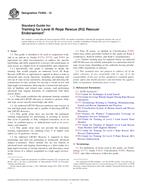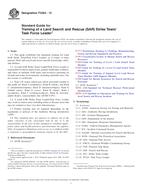Potřebujeme váš souhlas k využití jednotlivých dat, aby se vám mimo jiné mohly ukazovat informace týkající se vašich zájmů. Souhlas udělíte kliknutím na tlačítko „OK“.
ASTM F2954-12
Standard Guide for Training for Level II Rope Rescue (R2) Rescuer Endorsement
Automaticky přeložený název:
Standardní Guide pro školení pro Level II Rope záchranného (R2) záchranář Schválení
NORMA vydána dne 1.6.2012
Informace o normě:
Označení normy: ASTM F2954-12
Poznámka: NEPLATNÁ
Datum vydání normy: 1.6.2012
Kód zboží: NS-54783
Počet stran: 7
Přibližná hmotnost: 21 g (0.05 liber)
Země: Americká technická norma
Kategorie: Technické normy ASTM
Kategorie - podobné normy:
Anotace textu normy ASTM F2954-12 :
Keywords:
extrication, rescue, rope, SAR, technical rescue, USAR, ICS Number Code 13.200 (Accident and disaster control)
Doplňující informace
| Significance and Use | ||||||||||||||||
|
4.1 This guide establishes a minimum standard for training rope rescuers as it relates to their rope rescue specific knowledge and skills. A person trained to this guide is an endorsed Level II Rope Rescuer (LRT-R2 Rescuer). 4.1.1 Every person who is identified as an endorsed LRT-R2 Rescuer shall have met the requirements of this guide. 4.1.2 This guide is only the second level of training for rope rescue personnel and, in conjunction with Guides F2209 and F2752, only establishes the minimum knowledge and skills required for a person to perform intermediate rope rescue. No other advanced skills are included or implied. 4.1.3 In addition to meeting the requirements of this guide, an endorsed LRT-R2 Rescuer shall also be adequately trained to operate effectively and safely in the environment in which he is expected to work (that is, wilderness, urban, industrial, and so forth). 4.1.4 Nothing in this guide precludes an AHJ from adding additional requirements for its own members. 4.2 Endorsement to Level II Rope Rescue (LRT-R2 Rescuer) is not an indication that a person possesses adequate field skills or knowledge to make mission-critical decisions. However, under authorized supervision, a person so endorsed is qualified to support a rope rescue team in an area with high fall exposure and/or falling hazard potential, including high angle environments. 4.3 This guide by itself is not a complete training document. It is only an outline of the topics required for training or evaluating an endorsed LRT-R2 Rescuer. It may, however, be used in the development of, or as part of, a complete training document or program. 4.3.1 This guide does not stand alone. It must be used with the referenced documents to provide the specific information needed by an endorsed LRT-R2 Rescuer or for an AHJ to properly evaluate a training program or text. 4.4 Though this guide establishes only minimum standards, it does not imply that an endorsed LRT-R2 Rescuer is a “trainee,” “probationary,” or other similar term member of an organization. It is the responsibility of the AHJ to determine the requirements and qualifications for member ratings. 4.5 Because technical rope rescue is inherently dangerous, and rope rescuers are frequently required to perform rigorous activities in adverse conditions, regional and national safety standards shall be included in agency and organization policies and procedures. An endorsed LRT-R2 Rescuer shall complete all activities based on an analysis of risk versus benefit, and shall follow applicable and mandated safety standards. 4.6 This guide can be used to evaluate a document to determine if its content includes the topics necessary for training an endorsed LRT-R2 Rescuer. Likewise, this guide can be used to evaluate an existing training program to see if it meets the requirements of this guide. 4.7 The knowledge and skill requirements in the following sections are not presented in any particular order and do not represent a training sequence. 4.8 Except where a physical skill needs to be shown, it is up to the AHJ to determine the best way to evaluate a person’s knowledge. This may be by written exam, oral exam, demonstration, or by some combination of the three. |
||||||||||||||||
| 1. Scope | ||||||||||||||||
|
1.1 This guide is intended to be used in conjunction with, and as an add-on to, Guide F2751 and Guide F2752 (or equivalent for other environments), to address the specific knowledge and skills required for a rescuer who participates in rope rescue at a higher level of responsibility and complexity. 1.1.1 Specifically, this guide is intended to define the training that would prepare an endorsed Level II Rope Rescuer (LRT-R2) or equivalent (under qualified supervision) to assist and support rope rescue operations at an intermediate level, including patient packaging, litter rigging, ascending and descending fixed ropes in a high angle environment, and constructing raising and lowering systems, in conjunction with other rescue duties. 1.1.2 This guide establishes the minimum training standard for an endorsed LRT-R2 Rescuer as related to general, field, and rope rescue-specific knowledge and skills. 1.1.3 An endorsed LRT-R2 Rescuer must work under the direct supervision of qualified rope rescue personnel. 1.2 An endorsed LRT-R2 Rescuer performs rope rescues in low and high angle terrain, and may serve as a litter attendant in low (but not high) angle terrain. An endorsed LRT-R2 Rescuer is capable of safely assisting rope rescuers who have higher level endorsements. 1.2.1 This guide alone does not provide the minimum training requirements for performing or assisting in rescues that occur in partially or fully collapsed structures, in or on water, in confined spaces, or underground (such as in caves, mines, and tunnels). 1.3 An endorsed LRT-R2 Rescuer is required to have knowledge and skill sets pertaining to the intermediate subject evacuation component of rope rescue. These include but are not limited to patient packaging, construction of an anchor system, construction of simple and compound rope mechanical advantage systems, and construction and use of lowering (fixed-brake) rope systems. 1.4 Type II teams, as defined in Guide F1993, which may utilize personnel trained to this guide are Kind A (wilderness), Kind B (urban), and Kind C (mountainous). 1.4.1 Further training may be required before an endorsed LRT-R2 Rescuer can actually participate on a particular kind of rope rescue team, depending on AHJ (authority having jurisdiction) regulations or policies. 1.5 This standard does not purport to address all of the safety concerns, if any, associated with its use. It is the responsibility of the user of this standard to establish appropriate safety and health practices and determine the applicability of regulatory limitations prior to use. |
||||||||||||||||
| 2. Referenced Documents | ||||||||||||||||
|
Podobné normy:
Historická
1.12.2010
Historická
1.9.2012
Historická
1.6.2012
Historická
1.5.2014
Historická
1.7.2013
Historická
1.5.2014
Odebírejte informace o nově vydaných normách ZDARMA:
Chcete pravidelně odebírat informace o nově vycházejících normách z celého světa a to zcela zdarma?
Přihlašte se k odběru. Vše je velice jednoduché a absolutně ZDARMA.
Na výběr máte vydavatele z celého světa.



 ASTM F2852-10
ASTM F2852-10 ASTM F2890-12
ASTM F2890-12 ASTM F2955-12
ASTM F2955-12 ASTM F2958-14
ASTM F2958-14 ASTM F3024-13
ASTM F3024-13 ASTM F3026-14
ASTM F3026-14
 Cookies
Cookies
